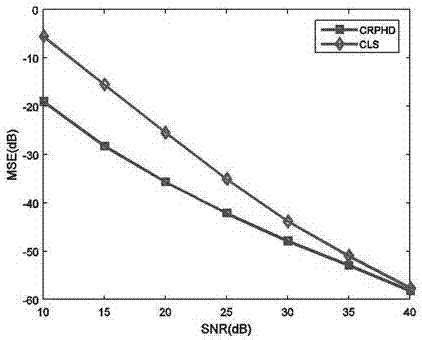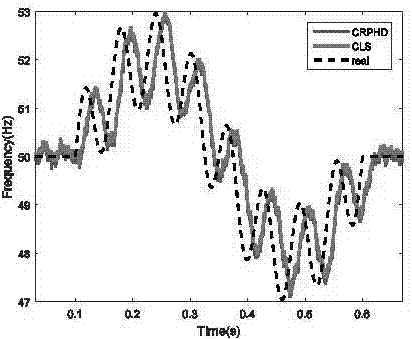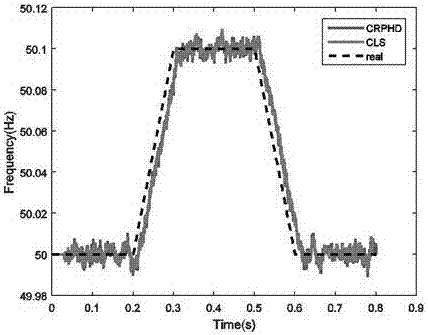Non-equilibrium system frequency estimation method based on improved SmartDFT algorithm
A technology of system frequency and frequency estimation, which is applied in the field of frequency estimation of unbalanced systems of SmartDFT algorithm, and can solve problems such as inaccuracy
- Summary
- Abstract
- Description
- Claims
- Application Information
AI Technical Summary
Problems solved by technology
Method used
Image
Examples
specific Embodiment 1
[0048] In this part, we will use the MATLAB platform to show the simulation results of the patented algorithm. We set the sampling frequency to f s =1600, the base frequency is f 0 =50, so, in order to calculate the fundamental frequency of DFT, the sampling point of the system voltage needs to be set as N=f s / f 0 =32. At the same time, we set the window length of the estimation algorithm as L=15.
[0049] First, we evaluate the superior estimation performance of the CRPHD algorithm relative to CLS in noisy environments. The true frequency of unbalanced system voltage f=f 0 +Δf is set at 51Hz, adding noise under different SNR conditions into the system, figure 1 The mean square error of CRPHD and CLS frequency estimation algorithms are shown, as shown in the figure, the proposed CRPHD algorithm is similar to CLS in performance, but under low SNR conditions, its estimation effect will be better than that of CLS algorithm.
specific Embodiment 2
[0051] In this group of simulations, we will study the frequency tracking performance of different estimation algorithms in the case of frequency fluctuations. On the basis of the original unbalanced system, the signal undergoes a complex sinusoidal frequency modulation f(t)=50+2sin(4π(t-0.1))+sin(32π(t-0.1)) at 0.1s to 0.6s, where ω 0 (t) = 2π·f(t), and add 10dB noise to the system at the same time. As shown in Figure 2(a), both algorithms can quickly and accurately track the dynamic changes of the system frequency. In Figure 2(b), the unbalanced system adds 40dB of noise at t=0s, and the system frequency experiences a rise of 1Hz / s, then remains at 50.1Hz for 0.2s, and then experiences from 0.5s to 0.6s A 1Hz / s drop. In all cases, both algorithms accurately tracked frequency changes.
specific Embodiment 3
[0053] In the final set of simulations, we investigate the robustness of the proposed algorithm under real-world power systems. Three-phase voltage signals are recorded in 110 / 20 / 10kV substations. The frequency of the three-phase voltage system to be measured is around 50Hz. After sampling at 1kHz, the voltage amplitude is normalized according to the peak value. In Fig. 3(a), the shown voltage experienced an unbalanced state around 0.27s to 0.54s, as shown in Fig. 3(b), although there was a brief fluctuation, the two algorithms performed well in both balanced and unbalanced voltage situations Accurate frequency estimation results are obtained.
PUM
 Login to View More
Login to View More Abstract
Description
Claims
Application Information
 Login to View More
Login to View More - R&D
- Intellectual Property
- Life Sciences
- Materials
- Tech Scout
- Unparalleled Data Quality
- Higher Quality Content
- 60% Fewer Hallucinations
Browse by: Latest US Patents, China's latest patents, Technical Efficacy Thesaurus, Application Domain, Technology Topic, Popular Technical Reports.
© 2025 PatSnap. All rights reserved.Legal|Privacy policy|Modern Slavery Act Transparency Statement|Sitemap|About US| Contact US: help@patsnap.com



